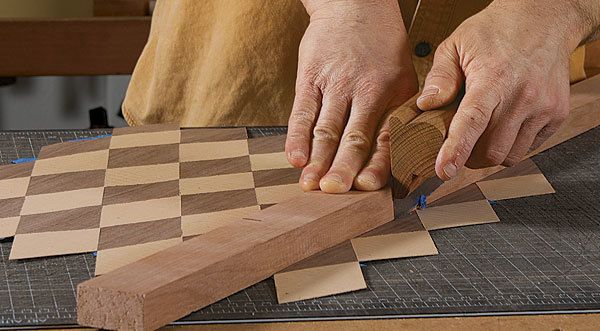Enliven Surfaces with Parquetry
Diamond and herringbone veneer patterns add pizzazz to furniture
Synopsis: Jazz up veneered panels with a diamond or herringbone pattern. This technique requires few tools and works with almost any veneer. Simply start with a stack of veneers in two contrasting colors, make a series of diagonal cuts to create strips with angled grain, then tape them together and cut again to create the diamonds. Craig Thibodeau explains the process step by step, then shows a similar technique to create a herringbone pattern.
While working on an entertainment cabinet decorated with hundreds of veneer diamonds, I needed a quick, accurate way to cut them. The technique I arrived at requires few tools and works with almost any veneer.
I start with a stack of veneers in two contrasting colors. Making a series of diagonal cuts, I create a set of parallel-sided strips with angled grain. I tape those strips together side by side, alternating dark and light. Then I cut this taped sheet on the opposite diagonal, producing strips of diamonds with the grain running perfectly from tip to tip. I tape the strips of diamonds together to make the final design. I use a similar technique to create a herringbone pattern of zigzagging stripes (see p. 86). These two patterns are only slightly more challenging than the chessboard I made in FWW #219 (“A Chessboard Made Easy”). See that article for an explanation of how to glue up and trim a marquetry panel.
Getting started
To cut the diamonds, you’ll need a veneer saw and a plywood cutting board about 12 in. wide by 24 in. long, with a stop glued to one long side. You’ll also need a cutting guide—a length of 3⁄4-in.-thick hardwood with straight, parallel sides, and sandpaper glued to the bottom for a firm grip on the work.
Lay out the pattern so the tips of the diamonds in the outside rows fall right at the panel’s edges. The pattern can grow or shrink a bit during cutting and assembly, so it’s best to start by making the diamond panels and adjust the rest of the piece to fit.
For an attractive pattern that is practical to make, I like diamonds with 60° points. Start by deciding how tall you want the diamonds. For 60° diamonds, make the cutting guide’s width half the height of the diamond. The width of each finished diamond will be 0.5775 times the height of the diamond.
For the full article, download the PDF below:
Fine Woodworking Recommended Products

Whiteside 9500 Solid Brass Router Inlay Router Bit Set

Bahco 6-Inch Card Scraper























Log in or create an account to post a comment.
Sign up Log in